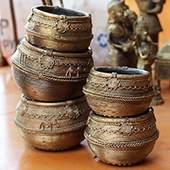Design Resource
Dhokra Metal Casting - Dhenkanal, Orissa
Traditional Craft
by
A clay mixture of mud, cow dung and water of appropriate ratio is kneaded thoroughly for the required consistency. Using this mixture of clay a core model is made. Upon this model a pure form of clay is applied as a layer for the smooth finishing. This model is allowed to dry completely. By using lengthy wax threads the whole clay model is completely wrapped with it to form a layer and to obtain the selected pattern of design. On this coating of wax layer, a layer of clay with sand is applied. Usually sand is used here for the purpose of tightness in the mixture. Two channels like holes are made on it and allowed to dry. In these two channels, one channel is made to pour the molten metal hence the other channel is automatically used for releasing the air out. After the clay model is completely dried, a layer of sand mixed with minimal amount of clay is applied. Thus the clay-wax model is totally set ready to bake. The model is thoroughly baked in furnace and the wax in-between the layers of clay gets melted and remains as a hallow space between the layers of clay. Further this model is taken out from the furnace and through a channel molten metal is poured into it. This molten metal is initially obtained by melting the metal crucibles in a graphite container. While heating/melting these metal crucibles a bit of salt is added to obtain the pure form of molten metal which also enhances the further process.
The molten metal poured into the clay mold acquires the shape and pattern of the model and acquires the impression of the wax model in fine details. This metal further gets hardened between the layers of upper and inner surfaces of the clay mould. Thus it is dipped in water to cool down the temperature of the metal. Once it is cooled completely then by slightly hammering and brushing the burnt mold, the metal artifact is thoroughly cleaned from both inside and outside. It is further polished all around and sold in market.
Flow Chart:























